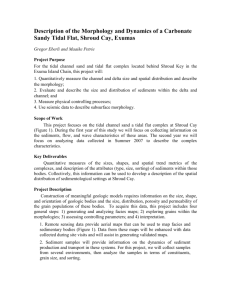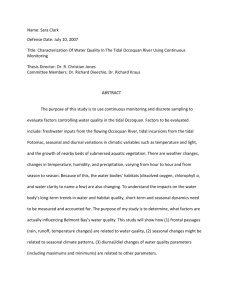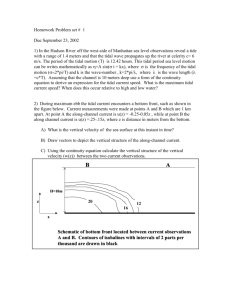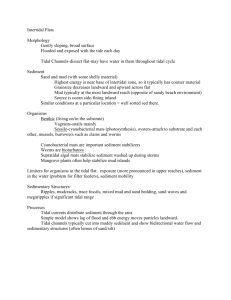Tidal environments - Personal.kent.edu
advertisement
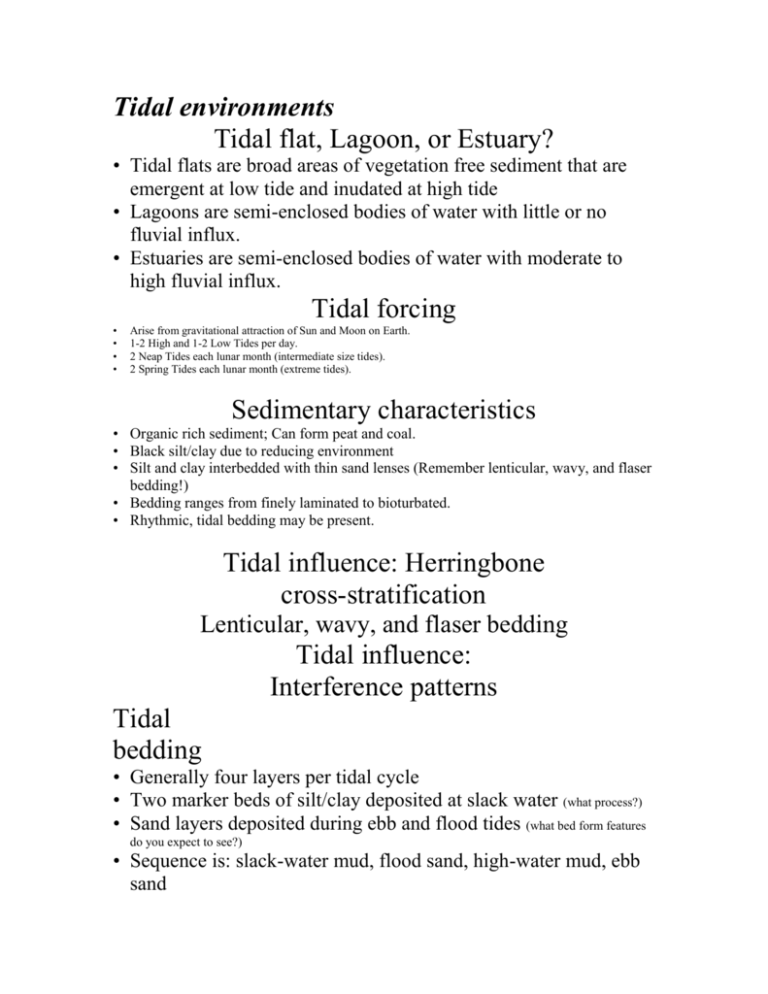
Tidal environments Tidal flat, Lagoon, or Estuary? • Tidal flats are broad areas of vegetation free sediment that are emergent at low tide and inudated at high tide • Lagoons are semi-enclosed bodies of water with little or no fluvial influx. • Estuaries are semi-enclosed bodies of water with moderate to high fluvial influx. Tidal forcing • • • • Arise from gravitational attraction of Sun and Moon on Earth. 1-2 High and 1-2 Low Tides per day. 2 Neap Tides each lunar month (intermediate size tides). 2 Spring Tides each lunar month (extreme tides). Sedimentary characteristics • Organic rich sediment; Can form peat and coal. • Black silt/clay due to reducing environment • Silt and clay interbedded with thin sand lenses (Remember lenticular, wavy, and flaser bedding!) • Bedding ranges from finely laminated to bioturbated. • Rhythmic, tidal bedding may be present. Tidal influence: Herringbone cross-stratification Lenticular, wavy, and flaser bedding Tidal influence: Interference patterns Tidal bedding • Generally four layers per tidal cycle • Two marker beds of silt/clay deposited at slack water (what process?) • Sand layers deposited during ebb and flood tides (what bed form features do you expect to see?) • Sequence is: slack-water mud, flood sand, high-water mud, ebb sand Tidal Bedding Model of Reineck and Wunderlich (1968) Tidal Flat Facies Model • • • • • • Fining upward sequence Coarse grained lower flat; herringbone x-beds Tidal bedding in mid flat Fine sediment in upper flat; mudcracks possible. Tabular in shape; usually meters in thickness Form parallel to coast line Barrier Complexes Economic importance of barrier complex sediments • Excellent reservoirs of oil, water • Host rocks for Uranium • Placer deposits for gold, diamonds, heavy minerals (e.g. Ti, Magnetite) Influences on coastal environments Classes of barrier complexes Barrier complex environments • • • • • • Shoreface Foreshore Backshore Tidal deltas Lagoons Tidal flats Tidal Deltas Shoreface environment • • • • • Wave base to low tide Inter layered fine sand and mud in shoaling zone Long shore sand bars in middle or breaker zone Complex cross bedding and long shore drift in surf zone Constant erosion and reworking; Poor preservation potential Swash Zone (Foreshore) • Region between tides • Influenced by breaking waves, swash and backwash • Coarse sands than shoreface • Placer deposits of heavy minerals may form Swash zone structures • • • • • Coarse sands well sorted Cross bedding usually perpendicular to the shore Seaward dip of 2-10° broadly lenticular Backshore and dunes • • • • Shoreward of the berm, the upper bound of the swash zone Landward dipping, low angle crossbeds in backshore High angle eolian cross beds in dune field Washover deposits of landward dipping sand sheets develop during storm related breaching of the dune field Washover deposits Barrier complex Time-transgressions • • • Inlet migration results in time-transgression fining upward sequence (see fig 9.21, 9.22c) Marine regression results in coarsening upward sequence of lower shoreface silt/clay environment to sandy dune environment as barrier progrades seaward (Common strat. sequence; fig 9.22a) Marine transgression results in a coarsening upward sequence from lagoon clays to backshore dunes; (Rare strat. sequence; fig. 9.22b) Inlet migration facies model Barrier complex facies changes Example: South African nearshore sequences Table mountain group - Peninsula formation (Ordovician age) Table Mountain Group • Ordovician age fluvial-marginal marine deposits • Piekenierskloof formation - Braided stream • Graafwater formation -Tidal environment (70 m) • Peninsular formation - Barrier complex (750 m) • Rare complete, transgressive marginal- marine sequence Graafwater Formation • • • • • • Intertidal deposits Flaser and lenticular bedding Soft-sediment deformation Sand filled mudcrack Interference ripples Herringbone cross-bedding Cyclic Graafwater Formation intertidal Shale and SS Results of Exam 1 Grading Scale: A >92 A- 89-91 B+ 86-88 B 81-85 C 75-80 C- 65-74


